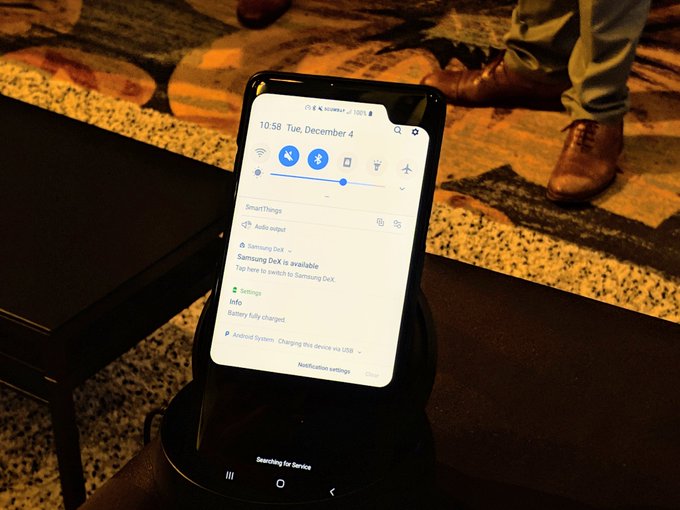It might not fold, but it sounds like there's still a lot to look forward to with the Galaxy S10 E, S10 and Galaxy S10 Plus
The Samsung Galaxy S10 range, which has a really cool codename inside the company, will be launched on Wednesday February 20, 2019. Samsung mobile chief DJ Koh has promised the forthcoming Galaxy S10 will feature "very significant" design changes and “amazing” colours, so it sounds like we could be looking at something truly special for the iteration of the Galaxy S line-up.
That makes sense given that the next flagship Galaxy S handset will mark the tenth anniversary of the wildly-successful smartphone range. As always with serious changes to the design of a flagship handset, expect to see a serious increase in price.
Of course, we don't expect the Samsung Galaxy S10 to be anything too revolutionary. After all, that honour is being reserved for the so-called Galaxy X, which will ship with two displays – including a 7.3-inch foldable OLED display that unfurls like the inside pages of a paperback to offer an optional tablet-like experience.
So, what do we really know about the next instalment of the hugely-popular Galaxy S range? Read on to find out.
SAMSUNG GALAXY S10 RELEASE DATE
The Galaxy S10 will be launched at an event on February 20, 2019. We know that because Samsung UK has sent out invites (with a '10' on them!) to a Samsung Galaxy Unpacked event in London at 7pm GMT. There will also be an event in San Francisco on the same day, that's 1am PT at the Bill Graham Civic Auditorium.
That's a little earlier than usual – after all, the Galaxy S9was launched at MWC on February 25, 2018 while the Galaxy S8 was unveiled in New York on March 29, 2017. However, it's worth noting the latter was an exception caused by the delays to the Galaxy S8 following the fallout from the overheating battery issue that did for the Galaxy Note 7. Until then, Samsung has used Mobile World Congress tradeshow to unveil its new flagship Galaxy S handset every year since the S5.
According to a report on Gizmodo, the latest Galaxy hardware will be available to pre-order as soon as the keynote finishes, with an official Samsung Galaxy S10 release date pegged for Friday March 8, 2019.

SAMSUNG GALAXY S10 NAME
Ever since the first Samsung Galaxy S saw the light of day in 2010, Samsung has stuck to an easy-to-understand naming convention, increasing numerically each year from Galaxy S2 to the S9, where we are now.
So the natural step for the 2019 Galaxy S would be Galaxy S10, right? Wrong. According to the latest hints from inside the company, as reported by The Investor, mobile chief DJ Koh said: "Although Samsung will stick to Galaxy, we have been thinking about whether we need to maintain the S moniker or the numbering system."
Best bets on the name should Samsung decide to drop the S10 from the brand name? Well, some sources claim an iPhone-alike Galaxy X name is on the cards, although that’s also the rumoured name for Samsung’s upcoming foldable phone.
One idea is that future phones will all be named the Galaxy X with the year of release afterwards, but that would get very confusing very fast. Samsung will probably wait until the last possible moment to let us know the new name, but if it's the end of the line for the Galaxy S moniker, it certainly had a good run.
SAMSUNG GALAXY S10 RANGE
Everything we've heard so far has indicated that the Samsung Galaxy S10 range will feature at least three models, codenamed "Beyond 0", "Beyond 1", and "Beyond 2".
Certification documents recently issued by the Chinese CMIIT government body confirms the administrative agency inspected three separate smartphones built by Samsung. These handsets appear to have all the hallmarks of the upcoming S10.
The model numbers are listed as SM-G9700, SM-G9730 and SM-G9750, which seem to the logical follow-up to the model numbers of the Galaxy S9 models, which were SM-G9600 and SM-G9650.
Based on the details included in the CMIIT reports, we're expecting the three versions of the Galaxy S10 to breakdown as follows –
- "Beyond 0": Entry-level S10 E with 5.8-inch display, single rear-facing camera and LTE
- "Beyond 1": Galaxy S10 with 6.2-inch display, dual rear-facing camera system, LTE
- "Beyond 2": Galaxy S10 Plus with 6.44-inch display and all-new triple camera set-up
- It's also been suggested the 5G version of Beyond 2 will have a 6.66-inch (!) display
The latter will be available in LTE and 5G compatible versions, the documents reveal.
As well as screen size and type, how the different S10 phones are specced internally also varies, with some S10 features (see below for details) exclusive to the top tiers.
A new report from GF Securities claims the maxed-out Galaxy S10 will ship with a staggering 12GB of RAM and a gargantuan 1TB of internal storage. That's more than most laptops even manage to offer.
This mammoth jump up in RAM will make for superfast image and video editing, still and video shooting, and gaming like never before.
This is likely a way to enable high-speed processing of the huge amounts of data that 5G will make the handset capable of receiving. On top of this, the 12GB of RAM could also be a way to future-proof the handset. This will allow it to be used in a headset for high-intensity virtual and augmented reality experiences.
Interestingly, the latest rumours suggest the S10+ (or Plus) will feature a 6.44-inch screen, which is actually bigger than that on the Note 9 phablet.
In order to make a handset with a pocket-busting display like that useable in day-to-day life, Samsung has engineered a new all-screen design. The company unveiled the new display technology amid a slew of new screen types – dubbed Infinity-U, Infinity-V, Infinity-O, and New Infinity – during its annual developer conference in San Francisco in November.
The first two sport small notches where the front-facing camera is still embedded in a solid bezel – much like the OnePlus 6T. The letters in the name refer to the shape of the bezel cut-out that holds the selfie camera and other sensors. For example, the Infinity V has flat sides and a sharp point in the notch, whereas the Infinity-U is all soft curves, like the shape of the letter "U".
Meanwhile, the Infinity–O has a small, floating pinhole at the top of the screen for the camera and the New Infinity has nothing at all. Previous rumours had hinted that Samsung had found a way to completely hide the sensors and camera lens behind the OLED display for a truly all-screen device.

(Image: © Android Police)
Samsung offered a very early glimpse at the upcoming hardware during the annual Qualcomm Snapdragon Summit in early December. But while the finished article is widely-tipped to sport an Infinity-O style display, with its small circular cut-out for the front-facing camera lens – the only break in an otherwise all-screen design, that's not quite what we saw with the prototype device.
Instead, we got an egregious, sweeping notch that dominates the top right-hand corner of the smartphone display. And this from the company that publicly mocked Google Pixel 3 for its notch design. Oh, Icarus.
Thankfully, this is not guaranteed to be the final design. In fact, Samsung Senior Vice President Justin Denison told TechRadar: "You should think of that device as a sample device. Not necessarily indicative of what the final device will look like, its size, shape, or even the UI treatment."
With any luck, the rumours are accurate and Samsung is able to make a slick, edge-to-edge smartphone with a small cut-out for the selfie camera – and it will not have to resort to shipping a handset with this odd, asymmetrical notch.
SAMSUNG GALAXY S10 5G CONNECTIVITY
According to a reliable tipster, the Samsung Galaxy S10 will let you tear across the web and through your apps faster than ever, because it's set to be one if not the first super-fast 5G smartphones.
Weibo user 'Ice Universe', who has a good track record when it comes to leaking sensitive Samsung tidbits, has revealed that the Galaxy S10 will come with the next-gen 5G technology on board.
Samsung has confirmed plans to launch a 5G-compatible handset in 2019 – however, it's unclear whether this will be the Galaxy S10, or another handset.
Earlier this week, the South Korean technology firm confirmed plans to partner with mobile carrier Verizon in the United States in order to bring the as-yet unknown 5G-compatible device to market sometime in the first half of next year.
However, if the aforementioned CMIIT government agency certification documents are anything to go by, Samsung will sell a separate version of the Galaxy S10 Plus that boasts the superfast network technology.
Whether 5G technology will be up and running in your part of the world by next year is another matter. However, a select number of UK, US and Chinese cities are scheduled to have it by the start of 2019, but it won't be ubiquitous for a while.
SAMSUNG GALAXY S10 SPECS

Samsung Exynos chip
Ice Universe has also revealed the Samsung Galaxy S10 screen is rumoured to "exceed 600 ppi". That would be an improvement on the display in the Galaxy S9, which has a resolution of 570 pixels-per-inch.
Powering everything could be the Qualcomm Snapdragon 855, if leaker Roland Quandt is to be believed. This will bring the expected improved performance and better efficiency over Qualcomm's current chipset, the same sort of upgrade we get every year from Qualcomm's latest chip.
Samsung Galaxy S10 will include the company's own Exynos chip in certain markets, as it did for the S9 in Europe with the Exynos 9810 this year.
The all-new system-on-a-chip from Samsung boasts an improved Neural Processing Unit (NPU) that handles on-device Artificial Intelligence (AI) processes, as well as an improved LTE modem capable of downlink speeds of up to 2.0 Gbps.
Exynos 9820 is the first Samsung system-on-chip that sports a dedicated AI chip, following closely in the footsteps of Huawei’s Kirin 980 and Apple’s A12 Bionic.
Separating the AI functionality from the main CPU should speed-up a whole slew of everyday smartphone tasks, like opening applications, playing resource-intensive video games, and taking photographs and videos.
According to Samsung, single-core performance is 20% improved than the previous generation Exynos chipset. Meanwhile, power efficiency is 40% improved, which should significantly boost battery life in any handsets powered by the Exynos 9820.
Like its predecessor, the next-generation Exynos boasts a security chip tasked with storing and managing personal and biometric data, including facial maps and fingerprint scans, in an isolated portion of the system. This should reduce the risk of attacks from cybercriminals.
Samsung is leveraging its NPU to improve images and videos shot on smartphones powered by the Exynos 9820. The dedicated coprocessor will uplift results in a similar manner to the Pixel Visual Core in the latest Google Pixel handsets.
According to Samsung, the Exynos 9820’s advanced image signal processor (ISP) supports up to five sensors – hinting at its ambitions to include a slew of camera lens into its upcoming smartphones and tablets. The improved silicon will also improve the speed of the autofocus
When it comes to video capture, the Exynos 9820 is capable of something truly special. The new chipset supports encoding and decoding of 8K videos at 30fps.
SAMSUNG GALAXY S10 FEATURES

The Huawei P20 Pro
Despite months of increasingly credible leaks, we never did see an in-screen fingerprint reader on the Galaxy S9, and while there were rumours the technology was being tested for inclusion on the Note 9, those whispers turned out to be false.
However, Samsung now appears to finally be ready to launch its hotly-anticipated in-screen fingerprint reader with the Galaxy S10 range. The South Korean company is purportedly working closely with Qualcomm, which recently unveiled a new ultrasonic scanner system, which can read and authenticate fingerprints through a glass display, on-stage during its annual Technology Summit.
The component – which tallies perfectly with the long-rumoured feature headed to the next entry in the Galaxy S series – will begin shipping in mobile devices in the first half of 2019, Qualcomm announced.
Qualcomm has branded its innovative new fingerprint scanner "3D Sonic Sensor". Unlike traditional optical sensors, the ultrasonic variant from Qualcomm does not compare the print against a two-dimensional pattern previously stored.
Instead, Qualcomm's all-new 3D Sonic Sensor creates a three-dimensional mould of the fingertip by bouncing soundwaves off the skin through the display. According to Qualcomm, the sensor can capture a breathtaking amount of detail – down to the individual ridges and pores. This makes it far more accurate than optical sensors that compare the pattern of the fingerprint.
Of course, the security community has yet to perform real-world tests to push the sensor to its limits, so it's difficult to judge whether the 3D Sonic Sensor is a genuine leap forward in security for mobile devices.
However, from a technology perspective alone, it seems like the new Qualcomm component should eradicate the possibility of fooling a smartphone fingerprint sensor with an accurate image of the print.
According to months of whispers from the supply chain, Samsung will include an ultrasonic sensor with its next-generation flagship smartphone. The security benefits of the new system could be a strong differentiator compared to rival handsets likes the Huawei Mate 20 Pro and OnePlus 6T, which favour optical sensors.
According to recent patents, Samsung will couple this 3D Sonic Sensor system with technology that allows phone owners to place their fingertip anywhere on the screen to verify their identity.
This is a dramatically different approach from rival devices, like the OnePlus 6T and Huawei Mate 20 Pro, which use a small portion of the screen to scan fingerprints, typically the same size as the physical sensors found on other smartphone models.
According to the patent, the fullscreen in-display fingerprint scanner would use a secondary, low-power processor to work. The new independent silicon ramps up the brightness of the screen as soon as it detects contact and scans the print pressed against the glass three times for security.
This would make the sensor more accurate than current in-display sensors – not to mention easier to use.
Like the Huawei Mate 20 Pro, the Galaxy S10 series is widely-tipped to be able to wirelessly charge other devices by placing them on the back of the handset.
SAMSUNG GALAXY S10 CAMERAS
Samsung always likes to focus on cameras, and with Huawei upping the ante with a triple-lens camera on the back on the Huawei P20 Pro, Samsung will want to respond. More lenses? More aperture settings? Better low light performance?
It all looks like it could be on the cards for 2019.
While the new Samsung Galaxy A7 has the company's first triple lens camera, Samsung looks set to enhance the specs for the Galaxy S10 and Galaxy S10 Plus.
According to the latest leaked S10 camera specs, the shooter on the flagship Galaxy range will include the same 12MP f/1.5-2.4 variable aperture lens that debuted on the Galaxy S9 paired with a super-wide angle 123-degree lens with 16MP sensor and f/1.9 aperture. Finally, Samsung will also purportedly include a 13MP f/2.4 aperture sensor.
These rumours of extra cameras are also seemingly backed up by phone industry analysts, with KBI Securities is claiming. Kim Dong-won says that Samsung plans to "reinvigorate" its business by adding a triple lens camera to the Galaxy S10.
As for other features, it's tricky to know what else Samsung could add to the existing S9 formula. We know that a foldable Samsung phone is in the works, but this is likely to be separate to the main Galaxy S line, with the foldable securely lodged in the top 5 foldable phones to expect in 2019.
SAMSUNG GALAXY S10 PRICE
Samsung has steadily increased the price of its flagship Galaxy S handset each year and – barring a massive economic downturn or sudden consumer demand for ridiculously expensive new technology – we expect this year to be no different in that respect.
The rising price tag of the Galaxy S series could explain why the South Korean company has decided to add its new "Beyond 0" lower-cost variant.
According to a reliable source speaking to Gizmodo, the following Galaxy S10 prices have now been confirmed by Samsung:
- 5.8-inch Galaxy S10 "Lite" with 128GB of storage: £669
- 6.1-inch Galaxy S10 with 128GB of storage: £799
- 6.1-inch Galaxy S10 with 512GB of storage: £999
- 6.4-inch Galaxy S10 Plus with 128GB of storage: £899
- 6.4-inch Galaxy S10 Plus with 512GB of storage: £1,099
- 6.4-inch Galaxy S10 Plus with 1TB of storage: £1,399
For comparison, the entry-level Galaxy S8 was released with a price tag of £639 ($725), while the Samsung Galaxy S9 sold for £739 ($720) at launch.
Given the introduction of a lower-end model and the improvements and tweaks purportedly planned for the Galaxy S10, the £60 increase on the previous model seems to make a lot of sense.
But what about prices on the other side of the pond? Unfortunately, a straight currency conversion doesn't offer many clues as history tells us that Samsung prices its handsets very differently on either side of the Atlantic.
For example, the Samsung Galaxy S9 launched at £739 in the UK, which equates to a whopping £935 when converted. That's not even close to the US price for the Galaxy S9, which launched with a $720 price tag in March 2017.
However, that's not to say that we can't read something into the leaked UK pricing. We can look at the percentage increase from UK pricing for the Galaxy S9 to the leaked Galaxy S10 prices and apply the same increase to the US Galaxy S9 launch prices. That should offer a better clue as to what Samsung might charge in the US.
For the Galaxy S10, the leaked UK launch price has increased by 8.12% over the Galaxy S9 launch price. For the Galaxy S10 Plus, the leaked UK launch price has increased by 3.45% over the Galaxy S9 Plus launch price.
Apply those price increases to the US launch prices of the S9 and S9 Plus, $720 and $840 respectively, and you'll get the best possible indication as to what you might be paying for the entry-level Galaxy S10 and S10 Plus when they launch next February.
Based on this calculation, Samsung Galaxy S10 will start at $779 and the Samsung Galaxy S10 Plus will start at $869.
As for the rumoured £1,399 price tag of the maxed-out Galaxy S9 Plus, this tallies with earlier reports on the handset. According to a report from South Korean news site The Bell published earlier this year, "in order to realise 5G communication" in the Galaxy S10 an extra "4 ~ 5 more antennas are needed than 4G".
It concludes: "the price of the series can be the most expensive."
A lot can change between now and then in terms of supply costs and global markets. We'll see whether we were right next year.
SAMSUNG GALAXY S10 CONCEPTS

A Galaxy S10 concept by designer Jonas Daehnert
(Image: © Jonas Daehnert)
While we wait to see what the final Galaxy S10 design looks like, graphic designers have been creating their own renders based on the various S10 leaks.
Recently, this rather tasty depiction of the Samsung Galaxy S10 was released by DBSDesinging, which shows a luxe all-screen smartphone with a triple rear camera.
The above render by freelance designer Jonas Daehnert shows the S10 with a transparent backplate, triple lens camera and in-screen fingerprint reader.



No comments:
Post a Comment